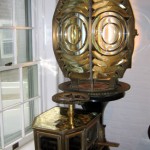
The following extracts taken from early Victoria, British Columbia (BC) newspapers are credited to Leona Taylor for her excellent work in indexing the papers. Full information can be found here: “Index of Historical Victoria Newspapers“, 2007-09.
*****************************
Esquimalt Lighthouse (Fisgard Lighthouse – ed) is now completed, except the lantern… [Colonist, 1860-06-09, p. 2]
By the Grecian the lanterns for the Fisguard Is and Race Rocks lighthouses, and the keepers of the same, arrived… [Colonist, 1860-08-09]
Schooner Meg Merillee has arrived from Barclay Sound, and reports that in passing the Race rocks yesterday morning a black flag was observed flying from the top of the lighthouse. Was it intended as a sign that some person had died? We feel anxious to know the cause of the display. [Workmen who had gone down to repair the lighthouse, and out of provisions, had lived on clams alone for 5 days] [Colonist, 1862-04-17]
It appears that on Xmas morning a Mr Warner, well known in this city, and a Brother-in-law of Mr Davis, the lighthouse keeper, started with his wife and a man of the name of Linton, a tailor, in a Whitehall boat for Race Rocks, intending to make a family party to commemorate the season. The boat was stocked with provisions, a portion of the usual supplies, which from some inadvertency had not been forwarded in due time. Upon passing Esquimalt, the sea being very rough, they pulled into the harbor and obtained the assistance of 2 men, Bill Saunders and Fred Simmons. They had nearly reached their destination when the boat was caught in a tide rip and capsized, precipitating the unfortunate occupants into the water. The loud cries for help immediately attracted attention at the lighthouse, and the residents were horror struck at the scene they were dammed to witness without the power to render the slightest aid. Warner rose twice to the surface, throwing up his arms, with agonizing appeals to his relations on the rock. The hopeless shrieks of the drowning resounded through the air, and yet there was no available means of rescue at hand to snatch the victims from a watery grave. At Race Rocks where human lives may be in peril at any hour of the day or night, complacent officialdom with an ostentatious affectation of retrenchment, decides there shall be no boat, not even a canoe, in the event of an emergency. Saunders in a fit of desperation, clambers on the boat, now bottom upwards, and clings to it, to use the words of an eye witness, ‘like a bear,’ and drifts seawards. For a few moments the waves float him within 20 yds of land, but, alas, no rope can be thrown to him and it transpires that the authorities have provided no life buoy as a provision against such a catastrophe. From a few minutes past 1:00 until 3:30 the boat with its hapless living freight remains in sight and then disappears. From all we can learn there would have been no loss of life if the keepers of the lighthouse had been granted a boat in response to their reiterated representations to the official authorities. The lifeboat originally used was withdrawn by the Surveyor-General for some reason and never replaced. The fate of Saunders is uncertain, but scarcely any hope is entertained that he can survive. The ubiquitous Costello, better known by his alias, of course turned up, having by some magical foresight come to the conclusion that something wrong had happened. He went out in his boat and upon arriving at the lighthouse gleaned the details of the affair and returned to town with Mrs Davis, who subsequently waited upon the Colonial Secretary with a report of the tragedy. It is only due to the public that some investigation should be instituted with reference to the gross negligence of those concerned in not providing for such a disastrous contingency. [Colonist, 1865-12-28, p. 3]